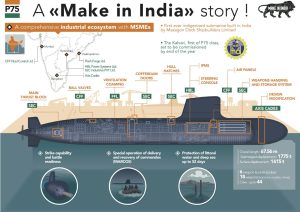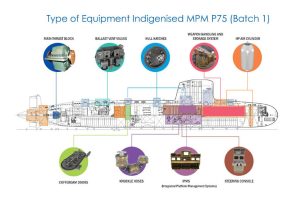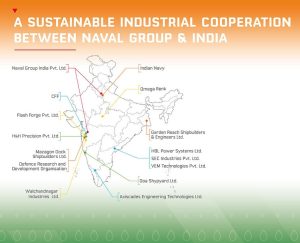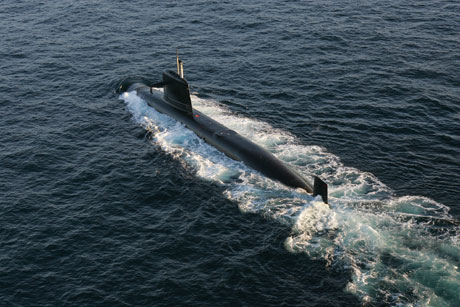
New Delhi. 01 June 2022. It is a journey which started from France for India and became a Make in India story to be told and re-told. It gave Indian defence power, Indian Navy stealth and Indian Ocean formidability. Naval Group which came to India as DCNS, and created the indegenisation footprint for all to follow. Naval Group India, which was established as DCNS India, is a 100 % owned subsidiary of Naval Group that is headquartered in Paris, France.
Going back into history, in 2005, a contract of strategic importance for the nation was signed between France and India for the construction of six submarines through a License Agreement. The Ministry of Defence and Indian Navy have chosen the shipyard Mazagon Dock Shipbuilders Limited (MDL) for constructing these submarines. Through a contract named P-75, MDL has forged a partnership with Naval Group (formerly DCNS) to build these submarines with P-75 Scorpene® submarine design. The construction is undertaken by MDL with a true transfer of technology from Naval Group.
For smooth operation of this contract, Naval Group set up a dedicated team at the shipyard itself, and also established a 100% owned subsidiary: Naval Group India with the head Office in Mumbai in September 2008. Naval Group India, along with its own activities, supports AOT activities and consistently helps Indian partners to contribute to the P-75 contract.

In MPM P-75 contracts, Naval Group has a contractual obligation: Indigenisation, where certain critical submarine equipment is manufactured by Indian partners through transfer of technology by Naval Group.
For a major part of the P-75 contract, Naval Group has a contractual obligation- Indigenisation, for which there are specific contracts for the provision of indigenously produced submarine equipment.
The dictionary defines indigenisation as the increase of local participation and capability to manufacture a product, or supply a service independently within a country instead of relying on foreign manufacturers or suppliers. The commitment of indigenisation involves entrusting a part of the production of submarine equipment, from the third submarine onward, to the Indian industry.
Scorpene® is a new-generation, conventional-propulsion submarines of an intermediate size and highly capable in terms of mobility and discretion, they are suited to a very broad range of operations. The Scorpene® submarine in India sees a strategic transfer of technology program for manufacturing of submarines at MDL Shipyard in Mumbai. This versatile and high-endurance submarine can carry out missions both in the open ocean and in coastal waters. Extremely stealthy and fast, it has a level of operating automation that allows the crew to be limited to 25, which reduces its operating costs significantly.

 Naval Group India has displayed continuous efforts of participating in various defence and renewable energy endeavours for the Indian Navy by empowering Indian industrial partners to cater to the requirements of the Indian shipyards and the Navy. Self-reliance, empowerment and innovation are the driving force for Naval Group India to better serve the rich Indian coastline.
Naval Group India has displayed continuous efforts of participating in various defence and renewable energy endeavours for the Indian Navy by empowering Indian industrial partners to cater to the requirements of the Indian shipyards and the Navy. Self-reliance, empowerment and innovation are the driving force for Naval Group India to better serve the rich Indian coastline.
The thrust to the industrial progress of India can be clearly attributed to the one-of-a-kind initiative called Make in India. India proves to be a strong contender on account of its increasing manufacturing skills.
Strategically significant projects have seen increased participation of indigenous content through a complex process of transfer of technology. Convergence of knowledge, ideas and competence amongst a wide array of cultures introduces an interesting element in the success story of indigenisation.
The endeavour of Naval Group India is to be a visionary and to further its involvement in empowering more and more industries by creating a robust eco-system that can cater to the varied defence needs of the country.


























































































































